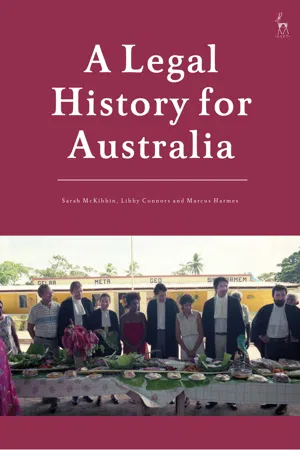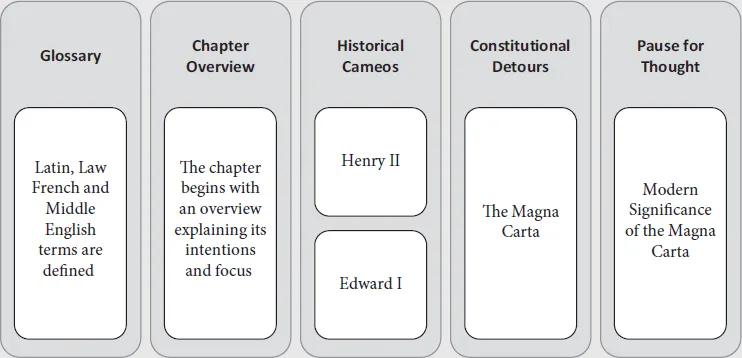Introduction
Medieval English law was the product of a different world and, in many respects, is remote and even terrifying. The opinions and precedents of medieval law survive in miles and miles of written texts that only specialists can decipher and translate. The people who were agents of and participants in the legal system can be hard to discern as individual personalities. Even so, from time to time, human personalities shine through in fascinating ways. Later in this chapter, attention will be focused on Edward I, one of the greatest rulers of his time. Yet however important he was, when a laundress complained directly to him that a man had raped her, but she had not yet received justice in her plea, Edward intervened swiftly and decisively. He wrote to the Earl of Cornwall, whom he had left in charge in England while fighting foreign wars, ordering restitution.1 Edward’s action is part of his direct involvement in English law, which mirrored other medieval monarchs whose involvement in the law was not ceremonial but actual.
Medieval law can seem remote because of its language and horrifying medieval punishments, but looking beyond that reveals a sophisticated system in operation and the personalities involved come into view. It is not static; Sir John Baker’s reminder quoted in the Introduction that legal history is the history of change rings true for medieval law.2 Many centuries of legal activity, developing actions, emerging and maturing legal doctrines and some of the greatest minds among the judges cannot be simply compacted to a simplified notion of ‘medieval’ law as something consistent and remote. The actions and doctrines as well as the personalities of medieval English law live on into the present.
This chapter offers a broad overview of the origins of the common law in England, with a focus on property law. Today, the common law exists in countries across the world that were once parts of the British Empire (such as Australia) or which began in the British Empire (such as the United States). There are, nevertheless, former parts of the British Empire that have not ‘received’ the common law – Quebec in Canada maintained French civil law; South Africa and Sri Lanka have Roman-Dutch legal systems inherited from The Netherlands (which held them as colonies before the British) in a hybrid with aspects of English law. The legal history covered in this text is also primarily English, not British. Scotland to this day has a different jurisprudence as the basis of its legal system, which has far more in common with European civil law codes derived from Roman law than English law.
This chapter charts the emergence of legal decisions based on precedent and legal actions based on writs from the Norman Conquest of 1066 onwards. Yet, consideration should be given to what came before the common law took hold. On that score, law and governance in Anglo-Saxon society opens this chapter, followed closely by the changes of the Norman Conquest. Feudalism, the Magna Carta, and the centralisation of royal justice are introduced as landmarks in thirteenth century law. The present though is never far away, and the chapter broadens to include the Mabo case, one of the most significant moments in Australian legal history, which will be considered here in relation to land tenure stretching from the Norman Conquest to the present era.
Learning Resources
The content in this chapter is supported by:
Learning Outcomes
At the end of this chapter, readers should understand:
•The impact of the Norman Conquest on English law.
•The historical importance of Henry II and Edward I in the development of common law.
•The symbolic and actual importance of the Magna Carta in modern Australian law.
•Feudal land tenure and its continued application in modern Australian law including in the context of Indigenous land rights and native title.
The Sources for Medieval Legal History
Seeking the origins of the common law means first asking what evidence survives from the past to reconstruct the legal processes, doctrines and people involved. Vast but incomplete records survive for medieval law. As a result, some important preliminary questions for any student of legal history are:
•Where do the documentary records for this subject matter come from?
•Where and how have they survived?
•How should they be interpreted, and how can they be interpreted?
Major gaps exist and knowledge of the history of medieval law is partial and far from systematic.3 These documents are not dead letters but lively and living sources of information that, in some cases, still have functional value. The sources bring to life a range of important aspects of legal history. Among them are laws – statutes and law codes – themselves. However, the personalities and priorities of the people who wrote, enacted, or were subject to the law are also recoverable. Sometimes the personalities of the clerks and lawyers stand out. In a case from the memorandum rolls of the Exchequer of Pleas, a clerk has drawn two barrels pouring out their content into a goblet, perhaps daydreaming as plea of trespass involving a wine broker was taking place!4 It is not possible to cover every surviving source for English law in this period; however, it is worthwhile having familiarity with some of the major sources of evidence.
Documentary Evidence
Documentary evidence are the working papers of the legal system as well as the public documents that announced legal circumstances (such as charters). Part of that process was the increasing attention paid to the keeping of centralised records by those in proximity to the monarch who administered justice – initially in person. The content of writs, the names of judges and other information about the workings of the court are here. Among these papers are:
•The pipe rolls are so called because they literally look like pipes. They are in fact layer after layer (each layer is called a membrane) of animal hides – a full sheep hide – on which financial information was ‘engrossed’.
•The Curia Regis rolls like the pipe rolls were documents recording the activities of royal justice.
•The plea rolls are the records written on parchment of writs and court proceedings and judicial proceedings, written by clerks in terse, brisk Latin.5
•The Year Books are in Law French and are a lively source for the interlocutory proceedings in the Court of Common Pleas.6 The legal profession truly comes to life. There are occasions where judges made dirty jokes that nineteenth century editors were loath to translate. Many witty comments made from the bench by John of Mettingham CJCP (died 1301) and William de Bereford CJCP (died 1326) were written down in the Year Books by people who clearly having fun listening to them. The Year Books record the judges and the many other people involved who are part of legal history. They are lively as students who were present in court watching the live proceedings unfolding most likely wrote them. They are also the forerunner to the formal reports (see chapter two). Law French is the archaic language spoken in the English law courts.7 Many of the terms used throughout this text, including jury, tort and attorney, are modern survivors of Law French. The Year Books are important sources for understanding the intersections between common law and civil law, and they often record judges, including Bereford, quoting Latin maxims from so-called ‘written law’ (civil or canon law) and showing the extent of common lawyers’ awareness of the rules of civil law.8
Treatises
The workings of the law and the reputation of the legal system were of great interest to the practitioners of the law in medieval England. Some wrote extensive theoretical or historical works about it in which they described the operations and personnel of the legal system. Major works include:
•Richard FitzNeal (died 1198) wrote Dialogus de Saccario (Dialogues of the Exchequer) in which he describes the officers, functions and working methods of the Court of the Exchequer, which was both a court and a Crown auditing office.
•Sir Ranulf de Glanvill (or Glanville) CJ (died 1190) is the attributed author of De Legibus et Consuetudinibus Angliae (On the Laws and Customs of England).
•Henry de Bracton JKB (died 1268) is also the traditionally accepted author of a treatise with the same title as Glanvill’s. Both are important early records of royal justice and the workings and traditions of the royal courts. Whoever wrote it, the author was aware of both Roman law but also used the rolls generated by the courts.9
•Sir John Fortescue CJKB (died about 1477) wrote two major treatises, In Praise of the Laws of England and The Governance of England. Both tend to idealise and, certainly, valourise the common law. Nevertheless, his work contains much valuable information on the workings of the legal system. Links to their works are available on the website.
Educational
Common law lawyers did not study at either of the universities (Oxford and Cambridge) until many centuries after the Middle Ages but they did receive a legal education. Works survive on what and how they learned and the daily workings of the Inns of Court where they lived and learned. For example:
•The Black Books of Lincoln’s Inn are the membership registers of this Inn of Court. The data is a significant source for observing the growth of the legal profession as the numbers of members of the Inn increase over decades and centuries.
•Statute books were a form of legal literature containing the body of statutes.
To bring the legal past to light and li...




